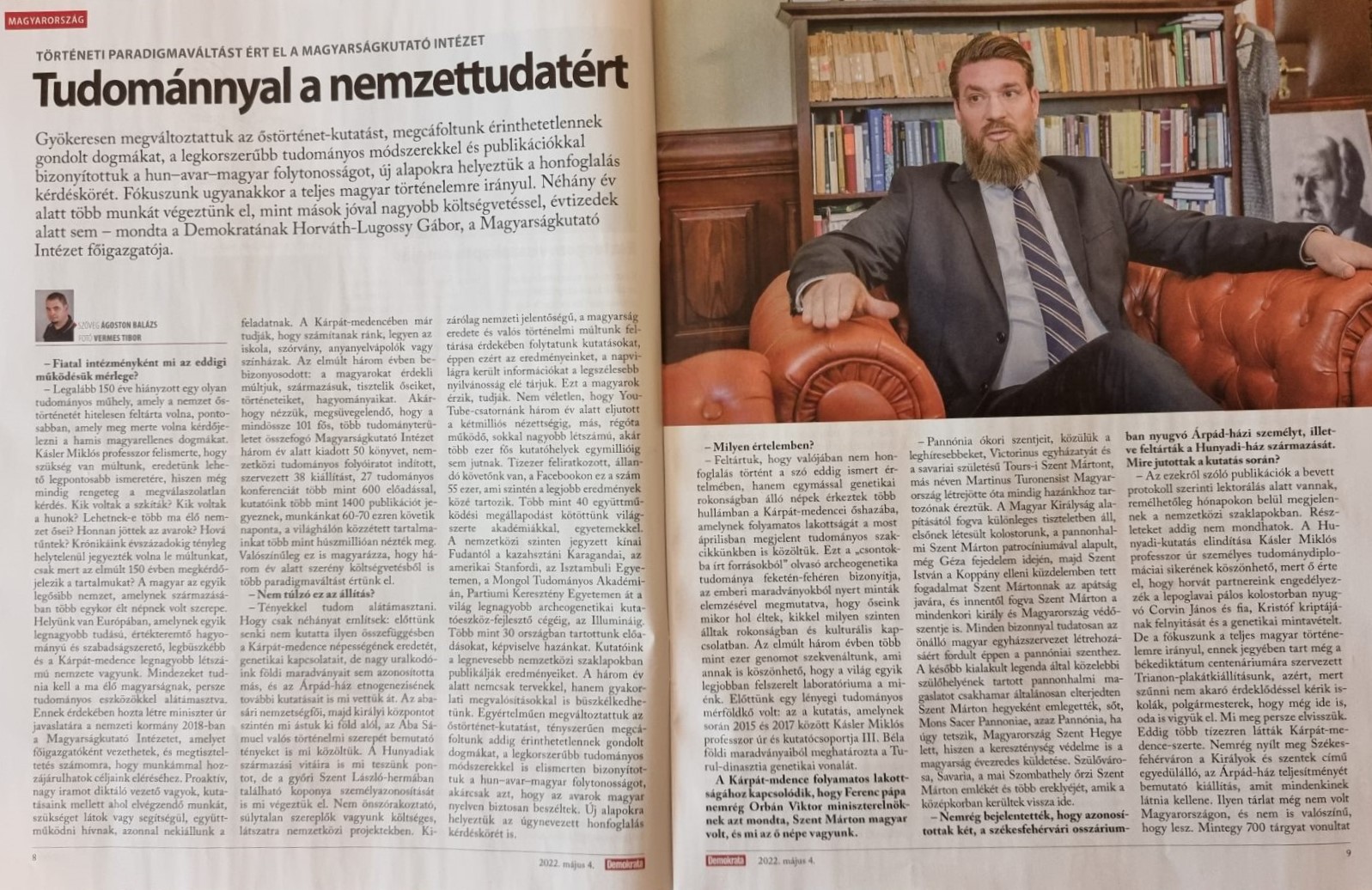With science for national consciousness - Interview with the Director General in Magyar Demokrata
The Institute of Hungarian Research, one of the flagships of the strengthening of national identity, has achieved a paradigm shift in research on prehistory.
"We have radically changed prehistoric research, we have refuted dogmas thought to be untouchable, we have proven the Hun-Avar-Hungarian continuity with the most modern scientific methods and publications and we have put the issue of the Hungarian conquest on new foundations. We have done more work in a few years than others have done in decades with much larger budgets," Gábor Horváth-Lugossy, Director General of the Institute of Hungarian Research, told weekly Demokrata. For at least 150 years, there has been no scientific establishment that would have authentically explored the nation's prehistory, or more precisely, that would have dared to question false, anti-Hungarian dogmas. Professor Dr Miklós Kásler recognized the need to discover our past, our origins, as accurately as possible, since there are still many unanswered questions. Who were the Scythians? Who were the Huns? Could they have been the ancestors of several nations living today? Where did the Avars come from? Where did they disappear to? The Hungarians are one of the oldest nations, with many other peoples having a role in their origins. We have our place in Europe, where we are one of the most knowledgeable, value-creating, freedom-loving, and proud nations. Hungary is the most populous nation in the Carpathian Basin.
[...]
No one before us has researched the origins and genetic relationships of the population of the Carpathian Basin in such a context, nor has anyone else identified the remains of our great rulers, and we have taken over further research into the ethnogenesis of the House of Árpád. We also excavated the site of the Abasár clan chiefdom and later royal centre, and we have published the facts showing the true historical role of Samuel of Aba. We also settled the disputes about the origin of the Hunyadi family, and we identified the skull in the Szent László herm in Győr," stressed our Director-General.

On setting the issue of the conquest on a new footing, he said, "We have discovered that there was no conquest in the known sense of the word, but that peoples genetically related to each other arrived in several waves to the ancestral homeland of the Carpathian Basin, whose continuous population was also highlighted in our scientific article published in April. This is proven in black and white by the science of archaeogenetics, which reads 'from sources written in bones', analysing samples of human remains to show when, where, with whom, and at what level of kinship and cultural contact our ancestors lived.
Gábor Horváth-Lugossy emphasized: “The launch of the Hunyadi research was due to the personal scientific diplomacy of Professor Miklós Kásler, who succeeded to convince our Croatian partners to allow the opening of the crypt and the genetic sampling of János Corvin and his son Kristóf, who rested in the Pauline monastery of Lepoglava. But our focus is on the whole of Hungarian history. In this spirit, our Trianon poster exhibition, organised to mark the centenary of the peace treaty, is still ongoing, in response to the unceasing demand from schools.
He also stressed the importance of disseminating scientific findings and facts. “In the case of prehistory, a good way of doing this would be to cooperate with the world of traditionalists. They are becoming better and more competent in presenting what researchers are discovering, and this would help to shape a broad national consciousness, which is also our task. That is why I have taken the initiative to set up a special college for the preservation of traditions within the framework of the National Cultural Fund, because if anything is part of our national culture, it is the tradition of our ancestors.”
As for the future plans of the Institute of Hungarian Research, he said that Mongolian-Hungarian scientific cooperation will continue in Belkh, and the excavation of the Hun tombs in Ar Gunt, 40 kilometres north of the capital, will begin.
[...]
"The archaeogenetic study of the Avar, Hun, Sarmatian and Scythian populations of the Carpathian Basin, as well as of the Hungarians of Árpád, will continue, including not only the elite but also the so-called common people of the cemeteries. This year, we will also place great emphasis on the excavation of domestic royal centres, which will help to create worthy memorial sites. We are also launching further international collaborations in order to identify members of all the eight royal dynasties buried in Székesfehérvár. The research of ancient inscriptions is important; a new field is epigraphy, which has excellent representatives in our institute. Several new scientific volumes in Hungarian and foreign languages will be published this year, and the letters of Mátyás Hunyadi, never translated before, will soon be available to the public.
This year we have already organised six conferences, we will also hold one in the framework of the Saint László Days in Nagyvárad (Oradea), and in the autumn we will organise another major international scientific conference in Budapest. We also plan to organise national exhibitions and continue our mission of science education through our increasingly popular thematic film series. We also want to start exploring the prehistory of the Pilis Mountains this year, in response to huge expectations."
Read the full interview in today's issue of Magyar Demokrata weekly.